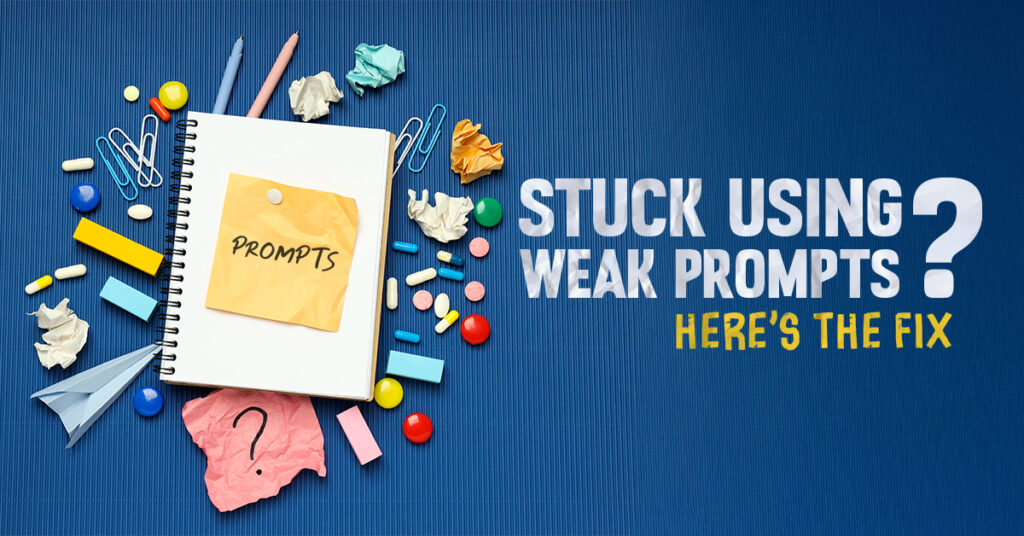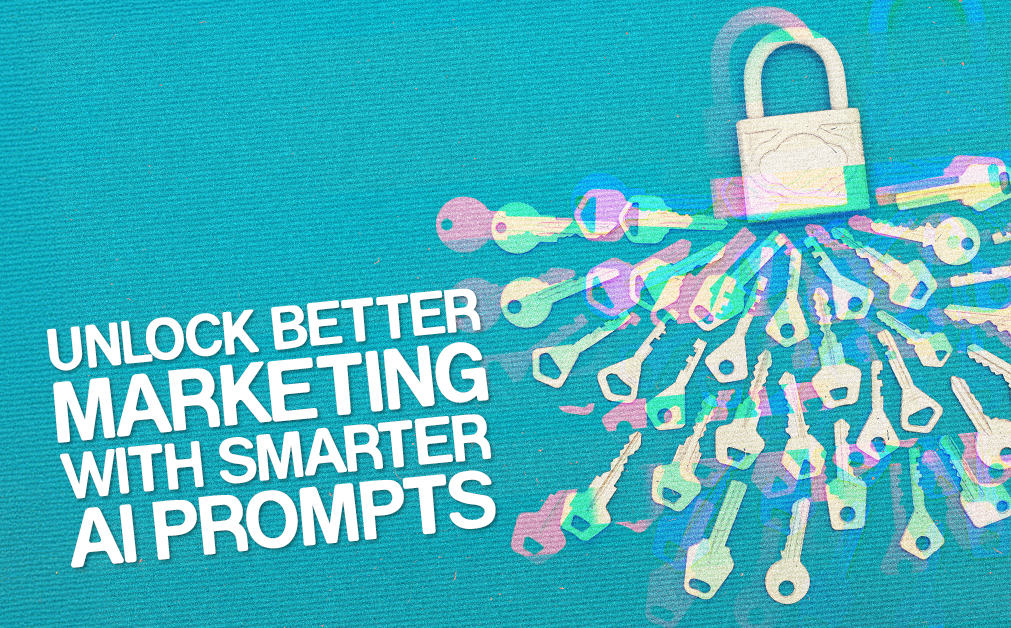Table of Contents
- Why Writing Good AI Prompts Matters
- The Building Blocks of a Strong AI Prompt
- Common Mistakes (and How to Avoid Them)
- Prompt Writing Frameworks You Can Use
- Marketing Prompt Examples That Actually Work
- Free Courses to Improve Your Prompting Skills
- Final Thoughts: Why This Matters for Your Marketing
- FAQs
Why Writing Good AI Prompts Matters
Using tools like ChatGPT, Copilot, Claude or Gemini is now part of the marketing toolkit – but how you ask matters just as much as what you ask for. If you’ve ever felt like the AI’s answers are generic, off-brand, or missing the mark, the problem is usually the prompt.
Think of prompting like briefing a team member. The better the brief the better the output. If you simply say, “write a social post,” you might get something vaguely on topic. But if you clarify the audience, tone, platform, and objective – you get something that feels far more aligned and targeted.
Effective prompting isn’t just a tech skill; it’s a marketing one. As Harvard notes, “The quality of your AI result is directly related to the specificity and structure of your prompt.”
When prompts include a context, role, clear objectives, brand tone, and measurable outcomes, they don’t just speed up your workflow, they also reduce rounds of editing, improve alignment, and ultimately drive better campaign performance.
Pro Tip: Start thinking of prompts as a briefing. You’re not asking a question – you’re giving instructions on how to get a job done properly.
The Building Blocks of a Strong AI Prompt
Before we jump into specific examples, let’s take a look at what makes a prompt effective.
According to Google, Grammarly, and Harvard, high-performing prompts typically address these 9 elements:
- Goals: What are your business goals and marketing strategy?
- Context: What’s going on in your business right now?
- Role: Who should the AI act as? (e.g. copywriter, strategist, designer)
- Task: What exactly do you want the AI to do?
- Audience: Who is the content for?
- Tone and voice: Should it be friendly, professional, witty, sarcastic?
- Format: Do you need a caption, headline, email, script?
- Constraints: Word count, structure, platform guidelines?
- Outcomes: What is the purpose of the content?
It might seem excessive for a short social post, but when you’re scaling content across multiple platforms and campaigns, clarity is a time-saver – not a luxury.
“The more detailed and specific your prompt, the more relevant and useful the AI’s responses will be.” – Grammarly
“Think of a prompt as a recipe – the better your ingredients and instructions, the more consistent your outcome.” – Harvard HUIT
Pro Tip: You can’t bake a cake correctly if you miss the ingredients or change the process. So consider all the information that you would give to a staff member in order to get a job done correctly, then you are on the right track.
Common Mistakes (and How to Avoid Them)
Even experienced marketers can miss the mark with prompting. Here are some of the top pitfalls to watch out for:
1. Vague Requests
Too general = bland output.
Use these 9 elements as a checklist, before producing any AI generated content.
✅ Goals
✅ Context
✅ Role
✅ Task
✅ Audience
✅ Tone and Voice
✅ Format
✅ Constraints
✅ Outcomes
2. Missing Context
AI tools aren’t mind readers. Without background info, responses will be random, provide no new information and often be irrelevant. Clarify your business goals, marketing strategy, product, audience, timing, what’s happening in the market and what you are hoping to achieve.
3. Forgetting Format
Don’t assume the tool knows what you want. Be explicit in the output you want: a caption, headline, meta data, video script, bullet list, long-form article or table.
4. No Audience Focus
Knowing who the content is for shapes tone and content. AI needs to know if it’s writing for C-suite execs, tradies, or eco-conscious millennials and what tone of voice to use that matches your brand.
5. No Role Assigned
Giving the AI a role helps shape research strategy, tone of voice and relevance of information. Examples include:
- Act as a sales coach.
- Act as a journalist.
- Act as a managing director.
All 3 examples will yield a different output.
Action Step: Review your last 3 prompts. Did you include all 9 elements in your prompt?
Will AI revolutionise your business marketing success? Find out here.

Prompt Writing Frameworks You Can Use
If you’re unsure how to structure your prompt, these frameworks give you a starting point that can be personalised for your business or campaign.
Think about the platform when utilising these frameworks. A Facebook ad needs urgency and character limits, whereas a thought leadership blog needs clarity and a professional tone. A blog post demands depth and structure, but an Instagram caption needs brevity and tone.
Each framework is flexible, but should be modified to suit the intent and channel. Always align the input with the output’s purpose.
R–T–F: Role → Task → Format
When to use it: For quick content like emails, posts, or ads.
Example:
- Role: Act as a Facebook ad strategist.
- Task: Write copy for a new product launch campaign aimed at tradies.
- Format: Two ad variations: headline + primary text.
T–A–G: Task → Action → Goal
When to use it: For audits, reviews, or analysis prompts.
Example:
- Task: Review the last 30 days of Instagram posts.
- Action: Recommend 3 improvements.
- Goal: Boost profile visits by 25%.
C–A–R–E: Context → Action → Result → Example
When to use it: For more complex outputs, like PR, thought leadership, or campaign strategy.
Example:
- Context: We’re launching a new line of reusable coffee cups.
- Action: Write a press release for Australian media.
- Result: Highlight our sustainability mission.
- Example: Reference KeepCup’s 2023 campaign.
Takeaway Tip: Once you’ve got a prompt that works, save it in a shared doc or prompt library. Great prompts are reusable assets.
Need help pulling your strategy together? Explore our marketing services
Marketing Prompt Examples That Actually Work
Let’s bring it to life with some prompt examples across common marketing activities. These aren’t just good guesses; they’re crafted using the 9 essential elements of high-performing prompts: Goals, Context, Role, Task, Audience, Tone, Format, Constraints, and Outcomes.
By addressing each of these, your content will be closer to the mark and more aligned to your strategy. But remember, do not publish solely AI generated content without having a content specialist review.
Example 1: Welcome Email Series
Prompt:
- Role: Act as an email marketing specialist.
- Context: We’re launching an online course for small business owners who want to improve their digital marketing.
- Goal: To nurture new leads.
- Task: Draft a 3-part welcome email sequence.
- Audience: Small business owners, mostly time-poor and sceptical about marketing.
- Tone: Confident but friendly.
- Format: Three short emails with subject lines.
- Constraints: Under 200 words each.
- Outcome: Encourage engagement and lead to a discovery call.
Why it works: This prompt gives the AI a defined role, a campaign goal, a sense of who the audience is, and structural guidance. The result? Emails that feel on-brand, strategic, and cohesive.
Example 2: Thought Leadership Blog
Prompt:
- Role: Act as a B2B content strategist.
- Context: Our client is an IT consultancy helping businesses with digital transformation.
- Goal: To improve SEO and establish thought leadership.
- Task: Suggest 5 blog headlines and meta descriptions.
- Audience: IT managers and decision-makers.
- Tone: Professional and insightful.
- Format: Headline + 160-character meta description.
- Constraints: Must include the keyword ‘digital transformation strategy’.
- Outcome: Boost search visibility and credibility.
Why it works: The AI understands the why and the who behind the task, not just what to produce. This context improves headline quality and relevance.
Example 3: Instagram Caption for a Promotion
Prompt:
- Role: Act as a social media copywriter.
- Context: We’re running an EOFY sale on brand design packages.
- Goal: To increase enquiries.
- Task: Write 3 Instagram captions.
- Audience: Small business owners who follow us.
- Tone: Friendly, slightly cheeky.
- Format: Captions with emojis and hashtags.
- Constraints: Each under 25 words.
- Outcome: Drive urgency and clicks.
Why it works: Instagram content has specific tonal and formatting expectations. This prompt addresses them directly, improving output quality.
Pro Tip: Treat your AI like a new team member and provide a full briefing. The more context you provide, the better the result.
Want your content aligned with your brand tone and goals? Learn how we can help
Free Courses to Improve Your Prompting Skills
Education and practice are the keys to success. These short, practical courses will help with upskilling:
- Introduction to Generative AI (Google)
⏱ 45 mins — Solid overview of how AI works and where to start. - Prompt Design in Vertex AI (Google)
⏱ 3 hr 45 mins — Great if you want to go deep on prompt engineering. - Fundamentals of Generative AI (Microsoft Learn)
⏱ 36 mins — Simple, accessible primer on using AI at work. - AI Prompting for Marketers (HubSpot Academy)
⏱ 1 hr — Designed specifically for marketing professionals.
Top tip: Bookmark these resources for quick reference, especially as AI becomes more embedded in workflows.
Final Thoughts: Why This Matters for Your Marketing
AI won’t replace you – but it can make your process significantly more efficient.
By learning how to write better prompts, you’ll:
- Save time
- Get more consistent results
- Improve quality control
- Maintain your brand voice
- Scale your content efforts with less strain on internal resources
We’ve seen clients reduce content turnaround times by over 40% simply by introducing structured prompt templates into their internal processes.
One of our clients used an AI tool to develop newsletter content for the month ahead – freeing their team to focus on editing, performance, and strategy instead of starting to draft from scratch.
Keep in mind, this was only done with thorough briefing of the AI agent and ultimately the creation of a custom GPT.
As we always say: good content is strategic. So are good prompts.
Want better content from AI?
Book your FREE Marketing Check-Up and we’ll review your strategy and send you a free report.
FAQs
Q: What’s the best way to start writing better prompts?
Use a framework like R–T–F to structure your input: Role, Task, Format.
Q: Can AI create content that sounds like our brand?
Yes – if you guide it with brand tone, audience insights, and examples.
Q: How do I stop AI content sounding robotic?
Refine the prompt and edit the output. Think of it as your first draft, not the final copy.
Q: I’ve tried AI but didn’t like the results. Now what?
Revisit your prompt. Was it too vague? Add context, tone, and outcome expectations.
Q: Where can I learn more?
Check our blog for strategy, storytelling and design insights – or reach out for help with your marketing prompts and content planning.
